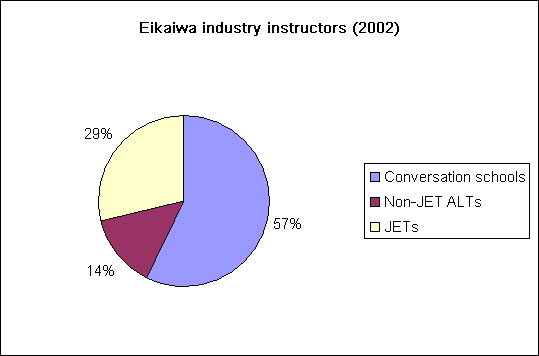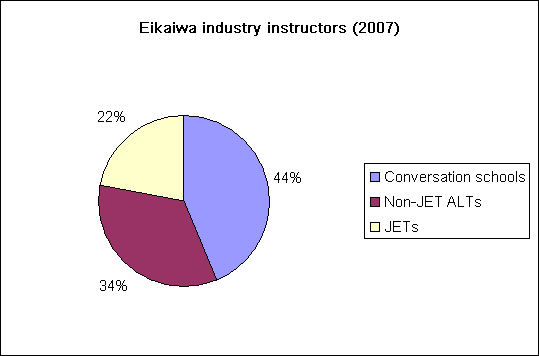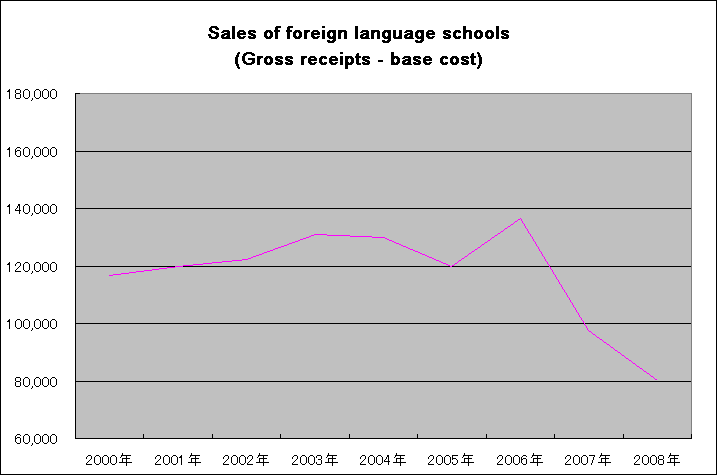(Updated below) (Updated again)
When I lived in Washington, DC, one of my part-time jobs was to teach TOEIC strategies mainly to Japanese bureaucrats and businessmen who were stationed in the area for one reason or another. They usually came as invitees of the State Dept. or, in the case of salarymen, sent by their companies to study the US patent system, auto crash test system, or other relevant area depending on their career track. The school was somewhat unique in that it was specifically set up to cater to Japanese customers, making it effectively an eikaiwa school in the US.
I was never a particularly good teacher. My experiences studying Japanese (at the time I had two years of study abroad in Kansai and the JLPT Level 1 under my belt) actually got in the way of my being an effective teacher, since I usually became so star-struck and curious about their government roles that it hampered their progress in getting through the TOEIC drills. Despite that (or perhaps because of it), the job was a very instructive experience for me, not least in terms of how adults try and learn second languages.
Students were typically early/mid-career bureaucrats in their late 30s or early 40s with no relevant international experience. Hence, their English levels all tended to hover around a fairly low level (TOEIC of around 500 or so, decent reading skills, next to no speaking and listening skills). This helped create a sense of community among the students, who often congregated for small-talk, safe in the knowledge that they were all in the same boat.
Intermediate students threatened this balance. “Intermediate” in this sense simply means a student who can express himself relatively fluently in some situations and maybe has some cultural fluency as well. Though the lessons were mostly one-on-one, during group lessons with the school’s president the intermediate always gained a reputation as “the fluent one.” As a result, the other students would defer to this more advanced student and consider him the standard for progress. Each time this happened, there was always at least one student who became discouraged and grew reluctant to express himself or really try and move forward on his own terms, especially in the group lessons. At the same time, I could detect a kind of jealousy of the intermediate students for getting ahead of them.
The intermediate students could sense how the others felt about them, and some seemed to even relish their top dog position. They tended to be prideful and resisted my suggestions that they needed help with key concepts. It became pretty frustrating at times because even the intermediate students couldn’t successfully understand our teaching materials, which consisted mainly of old TOEIC tests and NPR archives. Basically, they were riding high on the difference between a 600 TOEIC and a 700 TOEIC, which in reality isn’t all that significant.
In the end, this was a form of negative competition. Even if the people around you are more advanced, that doesn’t mean you have to compare yourself with them (at the school we would try and separate intermediate students if possible). And just as important, if you are ahead of your peers, that is no excuse to sit on your laurels. Since the wider world is much more competitive than your circle of acquaintances, it is important to identify your own strengths and weaknesses, and work from there.
Gaijin Hierarchy
The same thing happens among foreigners in Japan, and I am just as guilty of this behavior as anyone. Typically, even in casual conversation people in the Japanese as a second language community as well as the eikaiwa community will rank each other on their relative prowess in Japanese, and I am sure most readers of this blog have endured the utter awkwardness of the Japanese-language/Japanese culture knowledge “pissing contest.” I noticed this tendency very strongly over the (mostly off-topic) discussion at Japan Probe related to the allegations of fund misuse in the JET Program. Here is a typical example of this need to impose hierarchy (UPDATE: Not really, but it’s a good lead-off for discussion nonetheless. See comments for clarification):
Comment by Darg:
I’m a former JET, although I wasn’t an ALT. I was a CIR (Coordinator of International Relations), and have had this convo many times before. I really think the proper solution should be to put more focus on the international understanding and relations and less on the English teaching, and as a result have more CIRs and less ALTs.
I believe the CIR job is closer to the original intention of the JET program, and that is to promote cultural exchange. The problem is, most people don’t even know what a CIR is and think the JET program is a big waste of money because of the portion of ALTs that come out here and screw things up for the majority who actually try and get something done.
If they required a minimum of teaching experience for ALTs and raised the CIR:ALT ratio, I think a lot more people would appreciate the JET program.
This is objectively false (UPDATE: again, see comments for how I misunderstood what he envisioned CIRs doing). The program is called “Japan Exchange and Teaching Program” for a reason – historically, it was set up to place foreigners inside school classrooms to help with the drive to “internationalize” Japan through better English learning. The job of a CIR, on the other hand, is secondary to that priority – they typically assist with the “international” programs of a local city hall. The only basis for concluding that CIRs are more beneficial to the JET program than the ALTs – and this view appears to be common – seems to be the desire to believe that the advanced Japanese language requirements for CIRs actually mean something, as opposed to those illiterate ALTs who are allowed to come to Japan equipped with nothing but their English skills and the enthusiasm to teach kids.
In fact, while I have heard of a productive role for the Portuguese-speaking CIRs who help facilitate communication in towns with high Brazilian populations, others complain that CIRs are often given the basically pointless jobs of promoting multicultural events and maintaining sister city relationships. That these jobs require some Japanese competency does nothing substantially to improve the objective “worth” of these positions.
It is easy to make Darg’s mistake of dismissing ALTs’ role in supplementing the current, generally poor state of English language teaching and general proficiency, including among Japanese-national English teachers. This won’t go away overnight, and in over 20 years of the JET program not much seems to have changed. Commenter Jake brings this up:
Anyway, my point is that having a warm foreign body in every classroom in the country has become the status quo and nobody seems to be questioning that system itself — just figuring out how to maintain the system while cutting costs (i.e. handing all the contracts over to Interac). Then again, retooling the system to teach English in a manner that enables students to actually speak would also mean retooling the entire test-based educational system, and until that happens, pretty much any new policy implemented is going to be nothing more than a band-aid on a brain tumor.
Suggesting Japan should “retool the system” is MUCH easier said than done. Consider some of the moving parts involved:
- All schools, from elementary to university level, would have to turn their fundamental principles of education upside down (and have the talent infrastructure to understand and accept this new system); progress in the form of all-English education has been made on this front.
- Japanese-national teachers would have to become functionally fluent in English.
- Universities would have to reform their entrance procedures to emphasize English proficiency as it’s understood by most of the world (this is apparently underway).
- Parents would have to change their expectations for how their children study.
And on and on. Feel free to squabble over the details, but it’s clear enough that in the current environment, parachuting in “warm bodies” seems like a pretty good compromise. So despite all the insults I have dished out in the past, I really don’t think there is anything these ALTs/eikaiwa teachers should be ashamed of. In an imperfect system, they are playing an important role.
Yet I would argue that for the purpose of leading a productive life, it’s necessary to leave the whys and wherefores about eikaiwa aside. To a certain extent, supply and demand are beyond direct human control, and as a result much overarching debate on “the system” ends up being just another extension of the pissing contest.
But this point remains lost on too many with a vested interest in this issue – the teachers and those who look down on them in the milieu of gaijin society. Again and again, jobs that require Japanese in Japan are seen as more worthy than the dreaded English teacher position. Roughly speaking, I see the hierarchy as falling along these lines:
Japanese-speaking corporate executive > Professor > Interpreter > Token gaijin at a large corporation > Translator > Gaijin tarento > JLPT 1 passer > eikaiwa teacher-turned-entrepreneur > Journalist > CIR > Convenience store clerk/electronics salesman > Eikaiwa teacher > Street performer > Hostess
Relatedly, the group of Western expats who work for foreign companies and generally live in a Little America (think Hiroo in Tokyo or Rokko Island in Kobe) are usually not even included in this universe of possibilities, despite there being substantial overlap in practice.
Could there be anything more arbitrary and meaningless? In every other corner of the word it seems like people understand that people of different skill sets and living situations have different career needs, prospects, priorities, and ways of life, so why do the gaijin need to bitch so much?
The majority of non-soldier Western expats in this country are eikaiwa teachers, so it is an interesting phenomenon to see that many even in the profession see it as pointless and counterproductive to their careers. The people within that group easily end up like my former students — forming a pecking order based on Japanese language ability and overall J-savviness.
Why? For one thing, the gaijin community can be pretty isolated – it is a small subset of wider Japanese society, so if language or cultural barriers have kept you from really assimilating with the mainstream, the only real alternative is to stay with the people with whom you have common ties. A thousand and one Japan bloggers will tell you this can be lonely and frustrating. For another, it cannot be denied that there is some truth to the idea that many people who end up in Japan were either single-mindedly obsessed with Japan from the beginning or simply didn’t give much thought to a career until graduation rolled around. People whose jobs came as an afterthought might welcome a distraction from their own situations.
But most importantly, placing the eikaiwa teachers or those with poor Japanese on the bottom of the totem pole is a convenient and easy way to make people feel better about themselves. But again, it doesn’t actually help anyone – it’s just another form of negative competition. I hope the people living and working in Japan will step back from these false distinctions.
In terms of careers, eikaiwa teachers should try and think honestly where they are and consider where they would like to be, without worrying about whether their Japanese is up to snuff. Japanese is a lot of work, but it is doable and it will come. Or not. You will have to make the cost/benefit analysis of where your career is headed and whether it is worth it to stay in Japan at all costs or whether you might have better prospects back home, or even in a third country (I had a great time living in Bangkok). The economy isn’t all that great at the moment, but now is a good time to brush up on your strengths or the skills you wish were your strengths, whether they are Japanese language, network engineering, hip-hop dancing, or even English teaching.
Oddly, it’s the people supposedly on the top that might have the most to lose by “winning” this contest. Even if you have passed JLPT 1 and “escaped” eikaiwa, why not take a look in the mirror and consider your next move? Many of the people who have succeeded somewhat in assimilating did so by going out of their way to avoid contact with other Westerners, out of the fear that overexposure to their native language would hinder the Japanization process. While there is some merit to that, especially at the early stages, at some point you will have to stop seeing other foreigners as competition. You should feel comfortable enough in your position that you’re happy to help others.
Despite all the praise you might get for speaking good Japanese, Japanese language alone does not make a career (and if you want to be a translator/interpreter, it’s harder than it looks). Nor will it make you a very interesting person if that’s all you’ve got. And remember, if you become too self-satisfied with your supposedly lofty achievements you may be in for a rude awakening.
YET MORE UPDATES (No more Chuck Norris…): Here is an updated hierarchy thanks to the comments section (again, this is just a rough estimate based on my assessment of the state of gaijin discourse):
The emperor if he actually has a surfer dude accent > Steven Seagal > all foreign sumo wrestlers except Konishiki and those Russians that got caught with weed > Naturalized Japanese citizen (some overlap here)* > Street performer who hooked up with a famous idol > Japanese-speaking corporate executive > other foreign fighter/athlete> Attorney > Professor > Interpreter > Token gaijin at a large corporation* > Translator > Konishiki > Mombusho scholar > first-generation JET/BET who was totally not an English teacher > Translator who pisses on people > Professor who only teaches ESL > Jesus in Toyama > Gaijin tarento > JLPT 1 passer > JLPT 1 passer who speaks in dialect to show off > Genki English guy* > NGO Worker > eikaiwa teacher-turned-entrepreneur > Foreign Geisha > Journalist > high school exchange student > Akihabara tour guide (with Son Goku costume)* > Portuguese-speaking CIR > CIR > Convenience store clerk/electronics salesman* > Eikaiwa teacher >Bonsai (or other traditional Japanese craft) master > Bonsai (or other traditional Japanese craft) student > Buddhist convert > Shinto convert > Headhunter > Eikaiwa teachers who are milking the system > Street performer > Hostess > guy handing out event fliers in Roppongi > Foreign psychic > Evangelical Christian
* Position in hierarchy in dispute.




